KOREAVEIN
Central Varicose Vein Clinic
All surgeries are performed safely using semi-sedation and local anesthesia.
Central Varicose Vein Clinic does not rush the consultation
with the patients, and the patients are guaranteed of sufficient
amount of time to ask questions to the doctor for
preventing overtreatment and to guide
the optimum treatment method.
Central Thoracic Surgery does not
recommend or promote specific treatments
This is because the philosophy of Central Thoracic Surgery is that, just as a skilled craftsman does not blame the tools, the idea is that patients should be able to be treated no matter what surgical method is used.
All treatment methods (endovenous laser surgery, radiofrequency surgery, Venacil, Clarivein) performed at Central Varicose Veins Clinic are performed without incisions.
Even the slightest concerns the patient may have about the surgery
This is Central Varicose Veins Clinic’s know-how to block the source..
Intravenous Laser Surgery
Laser is shot inside the blood vessel through the optical fiber for closure of the problematic vein.
The Varicose Vein laser surgery is a legal non-payment item, and is applied with actual expense insurance when treating for the purpose of the disease.
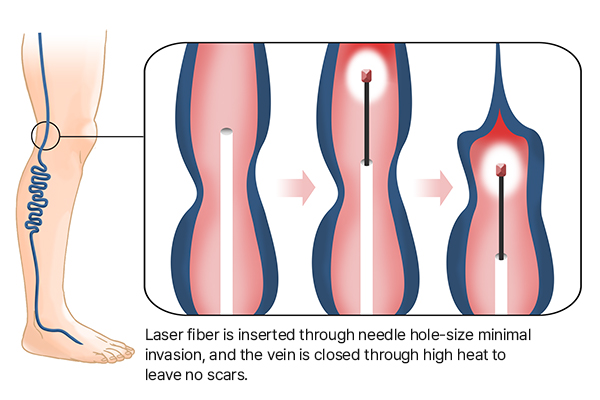
Intravenous laser surgery method
When an optical fiber slightly thicker than a hair is inserted into a venous blood vessel and a laser is fired, the inner lining of the blood vessel is damaged, reducing the thickness of the vein. Over time, it closes completely, preventing backflow of blood.
Cause Venous blood that was unable to go up to the heart due to blood regurgitation in the veins disappears and venous circulation returns to normal through other veins connected to the deep veins. Endovenous laser surgery is the most commonly used treatment method for varicose veins and has the advantage of having a shorter recovery period and leaving no scars than existing fundamental surgery methods.
-

Operation time
30minutes ~ 1hour
-

Anesthetic method
Semi-sedation,
local anesthesia -

Recovery period
Same-day discharge possible,
Daily life possible immediately after surgery -

Side effects
Temporary pain, bruising, and paresthesia
RF (Radio Frequency) Surgery
RF catheter is inserted inside the blood vessel instead of the laser optical fiber for closure of the problematic vein.
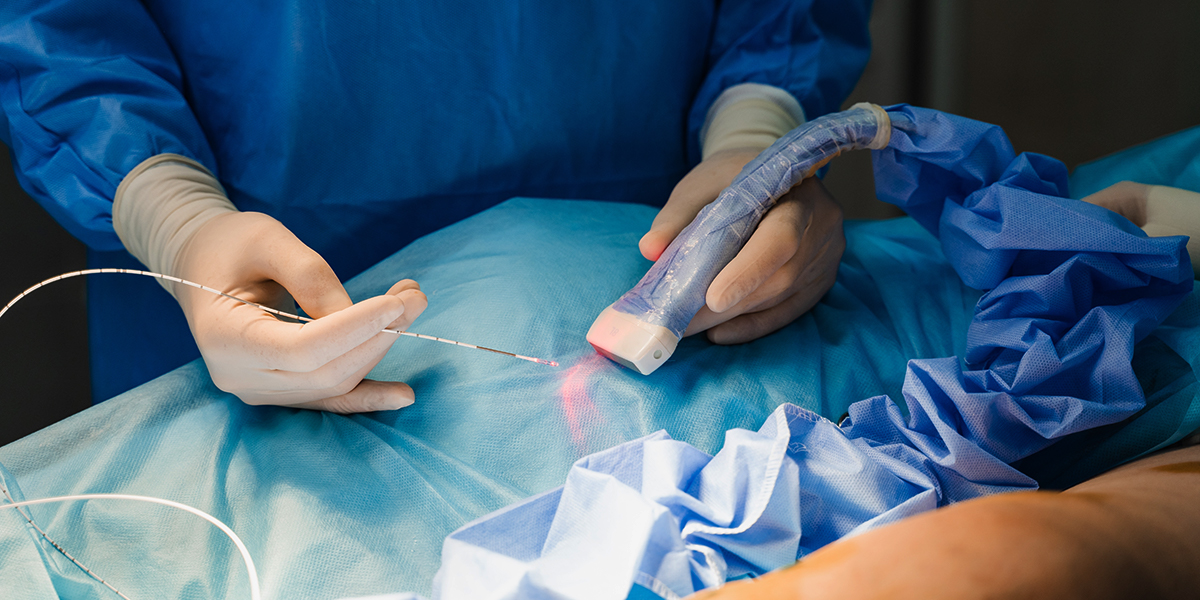
The principle of treatment
The principle of treatment is emitting 120˚C of heat inside the blood vessel to induce vascular fibrosis, and is same as the intravenous laser surgery.
(The actual expense insurance is also applied equally.)
-

Operation time
30minutes ~ 1hour
-

Anesthetic method
Semi-sedation, local anesthesia
-

Recovery period
Same-day discharge possible,
Daily life possible immediately after surgery -

Side effects
Temporary pain, bruising, and paresthesia
Cautions after the
intravenous laser & RF surgery
-
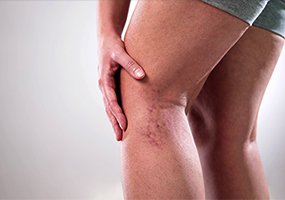
There can be bruises on the treatment site after the surgery due to the bleeding, but the bruises are normally disappeared within 2 weeks.
-

A stretchy feeling and discomfort of the surgery site is a normal therapeutic process from the laser or RF surgery, and the discomfort is disappeared after a certain period of time.
-

The patient should not take a hot batch for 1 week after the surgery. However, shower can be taken after removing the bandage on the following day.
-
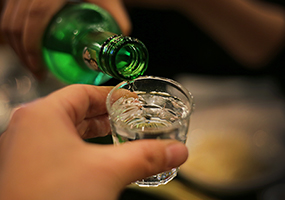
The patient should not drink for 1 week after the surgery. Drinking will result in the expansion of the blood vessels.
Venaseal
What is Venaseal?
Intravenous laser or RF surgery uses heat for closure of the problematic vein, but VenaSeal is injecting cyanoacrylate inside the problematic vein to adhere the lining of the blood vessel for closure. By using an adhesive instead of heat, there are advantages of less pain and also no scars like the laser / RF surgery.
-

Operation time
30minutes ~ 1hour
-

Anesthetic method
Semi-sedation, local anesthesia
-

Recovery period
Same-day discharge possible,
Daily life possible immediately after surgery -

Side effects
Allergy phenomenon
Traditional Surgery
This surgery was performed before the intravenous laser surgery was developed.
However, the traditional surgery is rarely performed recently due to the risk of complications, requiring a long hospitalization period, and big scar from the surgery.
(Phlebology 2012;27 Suppl 1:2-9)
(7) For treatment of the incompetent GSV, endovenous themal ablation (radiofrequency, RF, of endovenous laser therapy, EVLT) is recommended over high ligation and stripping of the saphenous vein. Recommendation: GRADE 1 (strong), level of evidence: B (medium quality)
(NICE guideline : Varicose veins in the legs 2013 10-11p)
Interventional treatment
- Offer endothermal ablation (RFA) and EVLT
- If endothermal ablation is unsuitable, offer ultrasound-guided foam sclerotherapy
- If ultrasound-guided foam sclerotherapy is unsuitable, offer surgery
Great Saphenous Vein Removal Surgery
Incision is made on sites near the groin and knee to find the problematic vein.
The wire is inserted into the vein in the groin to come out from the knee, and is tied with the vein to strip the vein on the knee for removal.
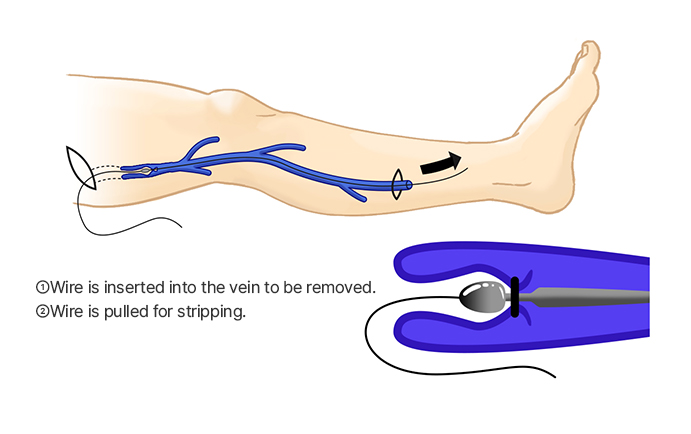
-

Operation time
30minutes ~ 1hour
-

Anesthetic method
Sleep anesthesia, local anesthesia
-

Recovery period
Daily life possible a few days after surgery
-

Side effects
Severe bruising pain
Clarivane
Percutaneous mechanical chemical venous occlusion is a treatment that causes physical stimulation to the inner wall of the vein using a rotating catheter and at the same time injects STS (Sodium Tetradecyl Sulfate) solution, which is used in vascular sclerotherapy, to block the problematic blood vessel.
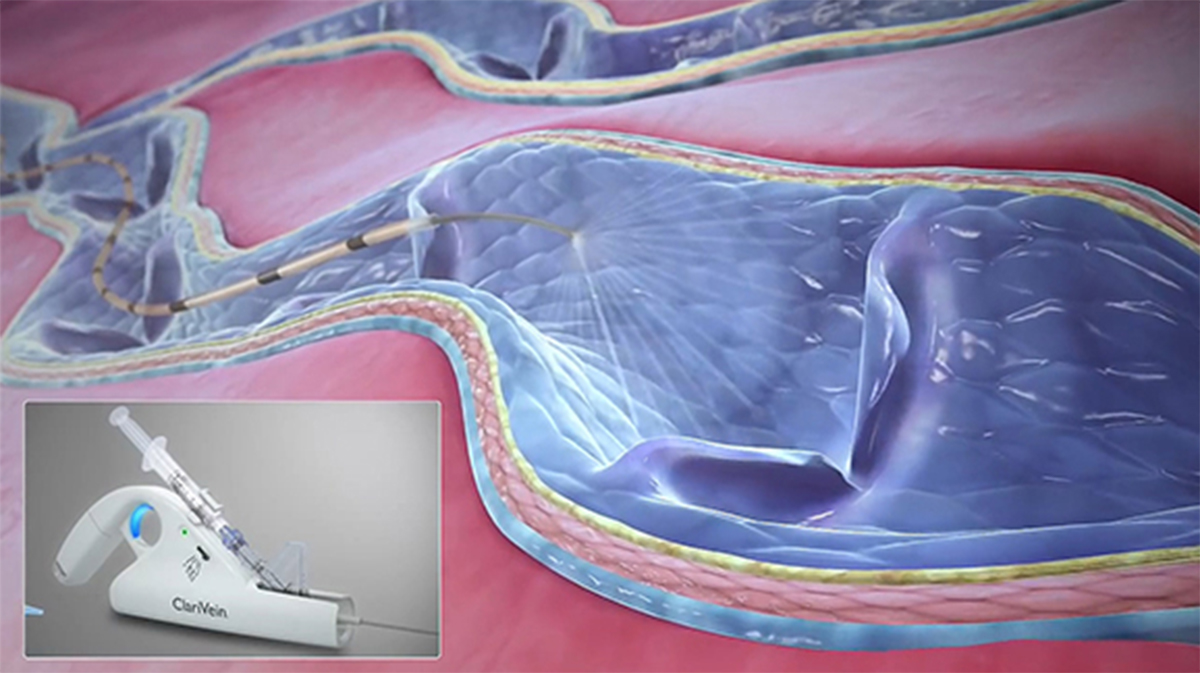
-

Operation time
10min ~ 15min
-

Anesthetic method
Semi-sedation, local anesthesia
-

Recovery period
Same-day discharge possible,
Daily life possible immediately after surgery -

Side effects
temporary phlebitis
Ambulatory Phlebectomy
As indicated, the patients receiving ambulatory phlebectomy can walk immediately after the surgery. A fine incision is made on the skin on top of the varicose vein for removal.
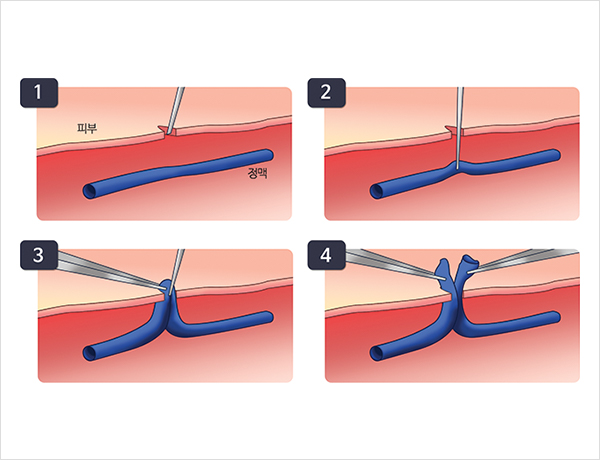
What is ambulatory phlebectomy?
A minimum incision is made after local anesthesia to remove the damaged blood vessel.
Simple treatment is performed under local anesthesia, and in varicose vein with severe expansion, more satisfying therapeutic effect can be experienced with the ambulatory phlebectomy within a quick period of time.
Ambulatory phlebectomy is recently being performed frequently due to minimum scars, and the surgery is performed together with intravenous laser treatment.
Central Varicose Vein Clinic has continued the research on intravenous laser surgery and sclerotherapy, and thus we are now able to perform treatment on most of the varicose veins without the concurrent treatment of ambulatory phlebectomy.
-

Operation time
10min ~ 15min
-

Anesthetic method
local anesthesia
-

Recovery period
Daily life possible immediately after surgery
-

Side effects
Mild pain, bruising
Telephone consultation & phone reservation
+82-10-6551-1597
82-2-566-7189






